A fit and flare dress is a dress silhouette featuring a fitted upper body (the "fit") and a full skirt (the "flare"). [1]
Contents
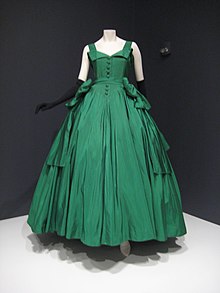
A fit and flare dress is a dress silhouette featuring a fitted upper body (the "fit") and a full skirt (the "flare"). [1]

Like the A-line silhouette, fit and flare dresses feature a fitted upper body and a wide hem. Both silhouettes flatter a wide variety of body types. The difference between the styles is that the fit and flare necessarily includes a fitted waistline while the A-line silhouette does not.[ citation needed ]
The origins of the fit and flare dress can be traced to the 1930s with the move away from the drop-waist silhouette of the 1920s.[ citation needed ] The fit and flare silhouette is linked to Christian Dior's "New LooK" of a cinched waist and full skirt that became popular in the post-war decades. [1] [2] Fit and flare dresses allowed women to show off the hourglass figure that was in vogue in the era. The flattering nature of the silhouette has ensured its popularity into the present day. [3]
Christian Ernest Dior was a French fashion designer, best known as the founder of one of the world's top fashion houses, Christian Dior SE. His fashion houses are known all around the world, having gained prominence "on five continents in only a decade."
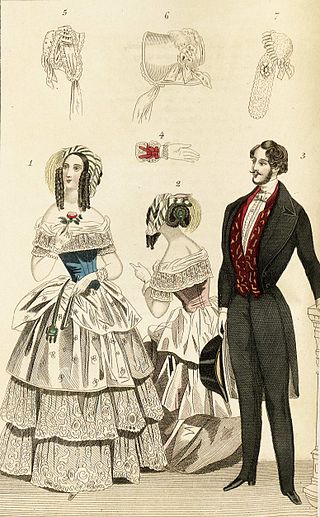
Victorian fashion consists of the various fashions and trends in British culture that emerged and developed in the United Kingdom and the British Empire throughout the Victorian era, roughly from the 1830s through the 1890s. The period saw many changes in fashion, including changes in styles, fashion technology and the methods of distribution. Various movement in architecture, literature, and the decorative and visual arts as well as a changing perception of gender roles also influenced fashion.
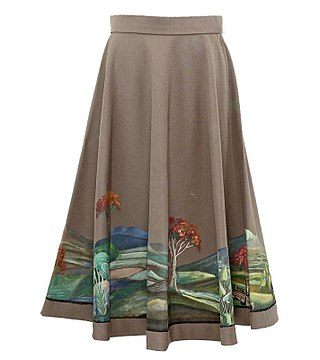
A skirt is the lower part of a dress or a separate outer garment that covers a person from the waist downwards.

Count Hubert James Marcel Taffin de Givenchy was a French aristocrat and fashion designer who founded the luxury fashion and perfume house of Givenchy in 1952. He is famous for having designed much of the personal and professional wardrobe of Audrey Hepburn and clothing for Jacqueline Bouvier Kennedy. He was named to the International Best Dressed List Hall of Fame in 1970.

Fashion in the 1890s in European and European-influenced countries is characterized by long elegant lines, tall collars, and the rise of sportswear. It was an era of great dress reforms led by the invention of the drop-frame safety bicycle, which allowed women the opportunity to ride bicycles more comfortably, and therefore, created the need for appropriate clothing.

1870s fashion in European and European-influenced clothing is characterized by a gradual return to a narrow silhouette after the full-skirted fashions of the 1850s and 1860s.

A bustle is a padded undergarment used to add fullness, or support the drapery, at the back of women's dresses in the mid-to-late 19th century. Bustles are worn under the skirt in the back, just below the waist, to keep the skirt from dragging. Heavy fabric tended to pull the back of a skirt down and flatten it. As a result a woman's petticoated skirt would lose its shape during everyday wear.
Drape suits are a 1930s British variation of the three-piece suit, in which the cut is full and 'drapes'. It is also known as the blade cut or London cut. The design of the athletic aesthetic of the drape suit is attributed to the London tailor Frederick Scholte. The new suit cut was softer and more flexible in construction than the suits of the previous generation; extra fabric in the shoulder and armscye, light padding, a slightly nipped waist, and fuller sleeves tapered at the wrist resulted in a cut with folds, or "drapes," front and back that created the illusion of the broad-shoulders and tight-waist "V" figure of the very fit.

An evening gown, evening dress or gown is a long dress usually worn at formal occasions. The drop ranges from ballerina, tea, to full-length. Such gowns are typically worn with evening gloves. Evening gowns are usually made of luxurious fabrics such as chiffon, velvet, satin, or organza. Silk is a popular fibre for many evening gowns. Although the terms are used interchangeably, ball gowns and evening gowns differ in that a ball gown will always have a full skirt and a fitted bodice, while an evening gown can be any silhouette—sheath, mermaid, fit and flare, A-line, or trumpet-shaped—and may have straps, halters or even sleeves.
Perry Edwin Ellis was an American fashion designer who founded his eponymous sportswear house in the mid-1970s. Ellis' influence on the fashion industry has been called "a huge turning point" because he introduced new patterns and proportions to a market which was dominated by more traditional men's clothing.
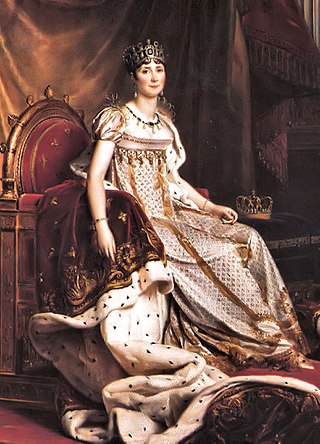
The waistline is the line of demarcation between the upper and lower portions of a garment, which notionally corresponds to the natural waist but may vary with fashion from just below the bust to below the hips. The waistline of a garment is often used to accentuate different features. The waistline is also important as a boundary at which shaping darts can be ended.
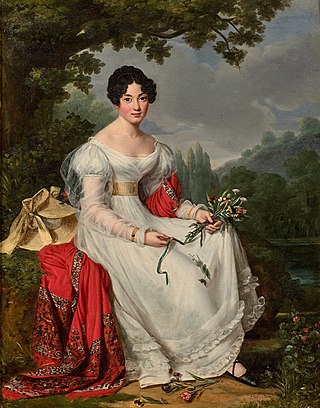
During the 1820s in European and European-influenced countries, fashionable women's clothing styles transitioned away from the classically influenced "Empire"/"Regency" styles of c. 1795–1820 and re-adopted elements that had been characteristic of most of the 18th century, such as full skirts and clearly visible corseting of the natural waist.

Fashion in the years following World War II is characterized by the resurgence of haute couture after the austerity of the war years. Square shoulders and short skirts were replaced by the soft femininity of Christian Dior's "New Look" silhouette, with its sweeping longer skirts, fitted waist, and rounded shoulders, which in turn gave way to an unfitted, structural look in the later 1950s.
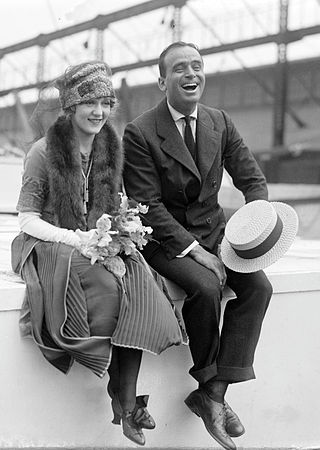
Western fashion in the 1920s underwent a modernization. For women, fashion had continued to change away from the extravagant and restrictive styles of the Victorian and Edwardian periods, and towards looser clothing which revealed more of the arms and legs, that had begun at least a decade prior with the rising of hemlines to the ankle and the movement from the S-bend corset to the columnar silhouette of the 1910s. Men also began to wear less formal daily attire and athletic clothing or 'Sportswear' became a part of mainstream fashion for the first time. The 1920s are characterized by two distinct periods of fashion: in the early part of the decade, change was slower, and there was more reluctance to wear the new, revealing popular styles. From 1925, the public more passionately embraced the styles now typically associated with the Roaring Twenties. These styles continued to characterize fashion until the worldwide depression worsened in 1931.

Fashion in the period 1900–1909 in the Western world continued the severe, long and elegant lines of the late 1890s. Tall, stiff collars characterize the period, as do women's broad hats and full "Gibson Girl" hairstyles. A new, columnar silhouette introduced by the couturiers of Paris late in the decade signaled the approaching abandonment of the corset as an indispensable garment.

An A-line skirt is a skirt that is fitted at the hips and gradually widens towards the hem, giving the impression of the shape of a capital letter A. The term is also used to describe dresses and coats with a similar shape.

A dress is a garment traditionally worn by women or girls consisting of a skirt with an attached bodice. It consists of a top piece that covers the torso and hangs down over the legs. A dress can be any one-piece garment containing a skirt of any length, and can be formal or casual.

Twelfth century European fashion was simple in cut and differed only in details from the clothing of the preceding centuries, starting to become tighter and more similar for men and women as the century went on, which would continue in the 13th century. Men wore knee-length tunics for most activities, and men of the upper classes wore long tunics, with hose and mantle or cloaks. Women wore long tunics or gowns. A close fit to the body, full skirts, and long flaring sleeves were characteristic of upper-class fashion for both men and women.
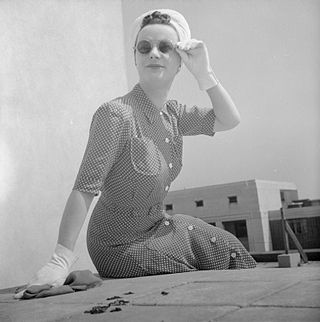
A shirtdress is a style of women's dress that borrows details from a man's shirt. These can include a collar, a button front, or cuffed sleeves. Often, these dresses are made up in crisp fabrics including cotton or silk, much like a men's dress shirt would be. As they are typically cut without a seam at the waist, these dresses often have a looser fit, usually relying on a belt to define the waist. Button fronts and a forgiving fit make this a flattering look for most body types.

Vera Borea is a French fashion house founded in 1931 in Paris, France, by Countess Borea de Buzzaccarini Regoli.